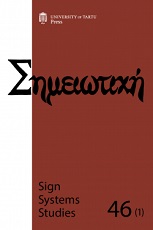The semiotics of models
The semiotics of models
Author(s): Winfried NöthSubject(s): Semiotics / Semiology, Theoretical Linguistics
Published by: Tartu Ülikooli Kirjastus
Keywords: model; diagram; metaphor; icon; legisign; type; token; C. S. Peirce;
Summary/Abstract: The paper sheds light on the concept of model in ordinary language and in scientific discourse from the perspective of C. S. Peirce’s semiotics. It proposes a general Peircean framework for the definition of models of all kinds, including mental models. A survey of definitions of scientific models that have been influential in the philosophy of science and of the typologies proposed in this context is given. The author criticizes the heterogeneity of the criteria applied in these typologies and the lack of a semiotic foundation in typological distinctions between formal, symbolic, theoretical, metaphorical, and iconic models, among others. The paper argues that the application of Peirce’s subdivision of signs into the trichotomies of the sign itself, its object, and its interpretant can offer a deeper understanding of the nature of models. Semiotic topics in the focus of the paper are (1) the distinction between models as signs and (mental) models as the interpretants of signs; (2) models considered as a type (or legisign) and models considered as tokens (or replicas) of a type; (3) the iconicity of models, including diagrammatic and metaphorical icons; (4) the contribution of indices and symbols to the informativity of models; and (5) the rhetorical qualities of models in scientific discourse. The paper argues in conclusion that informative models are hybrid signs in which a diagram incorporates indices and symbols in a rhetorically efficient way.
Journal: Σημειωτκή - Sign Systems Studies
- Issue Year: 46/2018
- Issue No: 1
- Page Range: 7-43
- Page Count: 37
- Language: English

